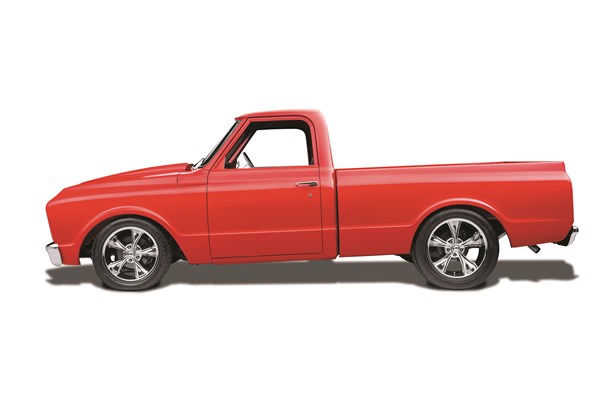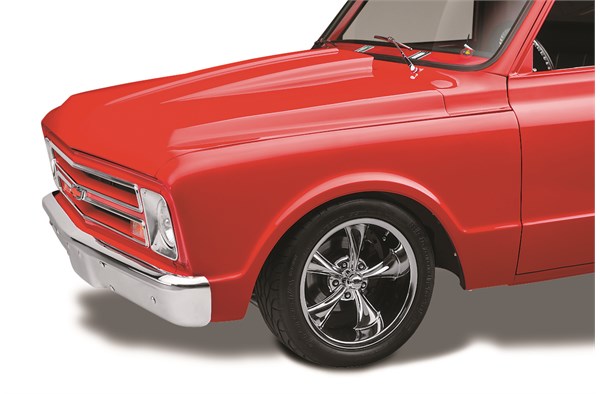They say beauty is only skin deep. To the casual observer, Matt Dillon’s 1967 Chevy C10 is a real treat for the eyes.
But, take a closer look and you’ll see the true splendor of this custom pickup transcends its stunning exterior—it’s a perfect 10 through and through.
Dillon set his sights on a C10 build at an early age. “I grew up in Wabash, IN working on trucks with my dad,” Dillon said. “I always wanted to build a big block, short bed, from the ground up.”
“My dad was always trading; anything he had was for sale. We’d go to Kentucky just about every weekend and buy something, fix it up, and sell it,” Dillon said. “We did engine work, bodywork, and paint in a garage with a dirt floor.”
As an adult, Dillon supplemented the solid skill set developed in his father’s garage by building an impressive collection of project vehicles, including a ’66 and a ’71 Nova SS, a ’96 Impala SS, and a handful of Chevy—you guessed it—SS trucks. When he bought a serviceable ’67 C10 from his buddy in Strawtown, IN, he found out he lacked one essential skill.
“The first thing I had to do was learn how to drive a three-speed column shift,” Dillon said. “I drove the truck around for about a month thinking about the build, and then one day I decided to tear it down.”
Hours later, the truck was in pieces and Dillon had a cell phone full of photos documenting the entire disassembly process. He prepped the C10’s factory frame to receive a complete Classic Performance Products coil-over suspension setup, plus a big, bad Chevrolet Performance 502 HO crate engine mounted 2 inches aft of its stock location. He sent the frame off to the powdercoating shop, and turned his attention to the truck’s vintage bodywork.
“We put the cab on the rotisserie, and I could hear something rattling inside the bodywork as it rotated. I couldn’t get it out, no matter how hard I tried,” Dillon said. Fortunately, his sister in-law Amanda stepped in with a plan to retrieve the offending noisemaker. “She put one of her lipsticks into an access hole and caught the stone that was making the noise,” he said.
Media blasting the truck’s sheetmetal revealed a host of hidden defects that Dillon corrected with brand-new floor pans and rocker panels. Then he cleaned up the C10’s classic lines by removing most of the exterior trim and smoothing the cab’s firewall and rear seam, the bed’s stake pockets, and the fuel spout (check out the slide show to see where the fuel goes now).
The build took a minor detour when the frame, big block, and customized cab came together for the first time.
“We lowered the cab onto the frame and the firewall hit the engine,” Dillon said. “I didn’t have a choice, so I cut the firewall to clear the engine and reshaped it with steel and fiberglass. After that, we put the cab back on the frame to make sure it would fit. Then we took it all apart again to paint it.”
With the sheetmetal wearing a beautiful PPG Victory Red finish, Dillon began the painstaking reassembly process.
“Even though we were careful, we still managed to scratch the paint,” he said.
Along the way, Dillon added some creature comforts like A/C and power windows. The new accessories combined with the increased electrical demands of the engine’s fuel injection system meant the factory wiring had to go. “I’m not that good at wiring,” Dillon said. “I used a Painless Performance wiring harness, and it really made the job easy.”
After countless hours, the truck was complete, and the results are nothing less than spectacular. The exterior’s crimson hue flows seamlessly into the truck’s cab, where it’s accented by a Billet Specialties steering wheel and a custom aluminum glove box cover. Black leather upholstery, carpet, and custom leather door cards complete the all-business interior.
Up front, the immaculately prepared engine bay is a testament to Dillon’s uncompromising craftsmanship and incredible eye for detail. Plumbed and wired to perfection, the fuel-injected 502 wears a March serpentine system and a full complement of polished accessories. A TCI TH-400 transmission sends the GM horsepower and torque to a Detroit Locker differential, and the truck rolls on a set of Ridler wheels wrapped with BFGoodrich g-Force radials.
In total, it took Dillon five years to give a run-down workhorse show-stopping good looks and tons of big-block performance to back it all up. He adds about 1,500 miles to the C10’s clock every year, refining his burnout technique—to the delight of his two sons—and cruising cars shows (and collecting trophies) with his wife, Brandy.
That sure sounds perfect to us!
Photography By: Maguire Photographics
FAST SPECS
Chassis
Frame: Stock, powdercoated
Rear End: GM 12-bolt, 3.73:1 ring and pinion, Detroit Locker differential, factory axles
Suspension: Classic Performance Products coil-over suspension system
Steering: Ididit steering column, Billet Specialties steering wheel, GM steering box
Brakes: Classic Performance Products 4-wheel disc brakes and brake booster
Wheels and Tires: Ridler 695 8 x 18-inch front wheels with BF Goodrich g-Force 255/45 ZR18 tires; Ridler 695 10 x 20-inch rear wheels with BF Goodrich g-Force 295/45 R20 tires
Engine and Transmission
Engine: Chevrolet Performance 502 HO crate engine, Chevy Bowtie valve covers
Induction: Arizona Speed fuel injection system, chrome-plated intake manifold
Ignition and Electrical: GM ignition and charging system, Painless Performance wiring harness, Summit Mini High-Torque starter
Exhaust: Stock exhaust manifolds ceramic coated, custom 2 1/4-inch stainless steel exhaust system, Flowmaster 40 Series mufflers
Transmission: TCI TH-400 transmission and torque converter
Other Items: Edelbrock water pump, March serpentine system, Dillon aluminum radiator and electric fans, Carter fuel pump
Exterior
Body: 1967 Chevy C10
Body Modifications: Goodmark cowl induction hood, smoothed cowl, stake pockets, and fuel spout
Paint: Victory Red
Body and Paint By: Kevin Richardson and Alan Music
Other Items: 1-piece windows
Interior
Upholstery: Tea’s bench seat with black ostrich inlay, black carpet, custom black leather door cards
Upholstery By: Collins Brothers Automotive
Awards
2012 GoodGuys Rod & Custom Association, Indianapolis, Indiana: LMC Trick Truck Pick
2013 Ducktail Run, Gas City, Indiana: Best of Show
2015 World of Wheels, Indianapolis, Indiana: ISCA Street Achievement Truck and First Place Truck Class
Special Thanks To: Kevin Richardson, the late Alan Music, Joe and Aaron Gribben, Rob and Jamie Dials, Wayne Hansen, Mike Catten, and M&B Body Shop










[…] It’s fair to say that 1963-72 Chevy and GMC C-Series Trucks are now bonafide classics. […]